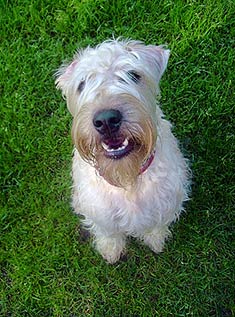Dog Breed:
Soft Coated Wheaten Terrier

Other Common Names:
Wheaten Terrier, Irish Soft-Coated Wheaten Terrier
Description:
The Soft Coated Wheaten Terrier has a rectangular outline and a head shaped like a long rectangle with a small strong jaw and a large black nose. This dog is distinguished by his soft, silky, wheaten colored coat.

Country of Origin:
The Soft Coated Wheaten Terrier originated in Ireland
Height:
Soft Coated Wheaten Terrier males range from 18 to 20 inches (46-51 cm.), females from 17 to 19 inches (43-48 cm.)
Weight:
Soft Coated Wheaten Terrier males weigh from 35 to 45 pounds (16-20 kg.), femailes from 30 to 40 pounds (14-18 kg.)
Colors:
Soft Coated Wheaten Terriers are born with a black coat; as they mature, it changes to the color of ripening wheat
Coat:
Soft Coated Wheaten Terriers have very distinctive coats which are not shed. It is silky and wavy, and must be combed daily to avoid matting.
Temperament:
An intelligent and loving breed, Soft Coated Wheaten Terriers do well with children and are very devoted to their families, but they will not get along with cats. They are playful, friendly and sweet-tempered.
Health Concerns:
The Soft Coated Wheaten Terrier is prone to flea allergies and protein wasting disease (PLE and PLN).
Life Expectancy:
The Soft Coated Wheaten Terrier can be expected to live about 12 to 15 years.
Living Environment:
Soft Coated Wheaten Terriers do well in apartments and require a small yard. They do not fare well in heat.
AKC Group:
Soft Coated Wheaten Terriers are in the Terrier Group.
Soft Coated Wheaten Terrier – now that’s a mouthful! Known simply as Wheatons to those who love them, this farm dog is full of energy throughout his life. They were originally bred in Ireland as farm dogs and family companions, but their popularity has grown worldwide due to their affectionate nature. Most Wheatons are real people-lovers and must be carefully trained not to jump up and kiss everyone they meet.
The exact history of how Wheatens came into being is unknown, but they definitely were the dog of the common man. In 1698, King William III issued a decree that restricted the ownership of sporting and hunting dogs to the gentry, leaving terriers to those of lower socio-economic means. The law read, in part, “only persons owning an estate of freehold of the yearly value of 40 pounds, at least, or a personal estate of 1,000 pounds shall keep any hound, beagle, greyhound, or land-spaniel other than whelps under the age of twelve months.”
So, the Wheaten was developed as a general farm dog in the Irish counties of Munster. They protected people and their property, herded cattle, hunted vermin, badgers, and foxes, and were sometimes used as hunting dogs to help procure the family’s meals. The Soft Coated Wheaten likely shares a common heritage with the other long-legged terriers of Ireland, the Irish and the Kerry Blue. The breed was first brought to North America in the 1940s, and their popularity took off during the 1950s.
As terriers, Wheatens are attracted to anything that moves. They can jump straight up and will chase rabbits, squirrels, cars, small children, and anything else they decide to follow. Training a Wheaten takes consistent discipline, as they want to be the leader and are very stubborn about taking direction. This is not to say that you should be harsh in your training methods. Positive rewards and patience will train the dog to be submissive to your commands, but will allow the Wheaten to retain his exuberance and high spirits.
Training should begin while your Wheaten is still a puppy and has an overflowing desire to please you. Although an adult Wheaten weighs only 30 – 40 pounds, they are such bundles of energy that they can be harder to train than most breeds. It is essential that you harness that energy before the dog reaches full size.
The breed standard for the Soft Coated Wheaten Terrier states that the dog should measure 17 – 19 inches at the withers (shoulders) and “present the overall appearance of an alert and happy animal, graceful, strong, and well coordinated.” The outline of the dog is angular, with a square-ish body and rectangle-shaped head. The coat is what really sets this breed apart from all others. The Wheaten has a single coat of fur that is soft and silky with just a bit of wave. In a puppy, the characteristic wave may not yet be present, but should develop by two years of age. The wheaten color may range from cream to dark tan and must be the only color present. The only exception is a blue-gray color that may shade the ears and muzzle.
Puppies may appear red, brown, mahogany, or white, but these colors grow out as the dog matures. An interesting trait is that when an adult Wheaten sustains an injury to the skin, the new fur grows first in a puppy color and then changes to the characteristic wheaten color over time.
The Wheaten does not carry a lot of dander in his fur, and is considered hypoallergenic for humans. Like human hair, the Wheaten’s fur continues growing throughout its life and needs regular trimming and grooming. There is minimal shedding, making the dog a favorite for those who hate vacuuming every day.
Wheatens generally live to the ripe old age of 12, but like all dogs, they are susceptible to certain genetic diseases. Most notably, these include protein-losing nephropathy and protein-losing enteropathy. Both of these conditions cause the dog to shed excessive proteins from the blood, either through the kidneys (nephropathy) or through the intestinal tract (enteropathy). Dogs are usually diagnosed between 4 and 6 years of age, and the condition is more common in females. Symptoms include vomiting, diarrhea, weight loss, lethargy, decreased appetite, and fluid accumulation. The diagnosis is made by measuring the amount of protein in the blood, urine, and feces. All Wheatens should be regularly screened for these diseases, as they are often fatal. Treatment includes a hypoallergenic, low protein diet. Females should not be bred to avoid passing on the disease and to avoid the stress of pregnancy, as stress makes the condition worsen.